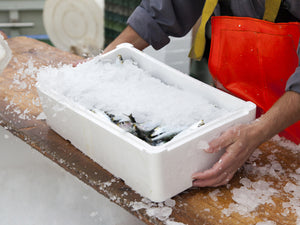Stop Paying for Ice: Glaze, The Frozen Fish Fraud
July 31, 2019

Ever noticed that layer of ice surrounding your frozen fish from the grocery store? Well, if you’ve tossed aside a packet of frozen seafood because you thought frost was “bad”, you’re not exactly wrong. But – you’re not entirely correct, either. Confused? Continue reading and let us explain.
Recipe By Seafood Crate
WHAT IS GLAZE?
You see: that layer of ice is also known as ‘glaze’ and serves as a protective layer for the packaged seafood. Without it, oxygen present in the air will inevitably dry out and react with the seafood’s fat content, turning your favorite halibut into a dehydrated, rotten mess. What’s more, it prevents the delicate meat from breaking up during processing, packaging, and transportation. Simply put, glazing is necessary for frozen seafood to ensure its quality.
The amount of ice found on the seafood differs based on the glazing methods used. The most common process – dipping – involves soaking frozen seafood in cold water. Another way is the direct spraying of seafood with a glazing solution.
THE “CATCH”? YOU’RE PAYING FOR WATER
So you’re probably thinking that glazing is terrific: it prevents oxidation, dehydration, and quality loss. But remember when we told you that there was a negative side to glazing? So what is it exactly?
Well, sometimes, the layer of ice is used not only to protect the packaged seafood but also to increase its weight. Unscrupulous companies in the seafood industry may look like they’re offering you a more economically advantageous product to you, but the 15oz of frozen Canadian halibut you bought at a ‘bargain’ could turn out to be just 13oz of meat. And you know what that means: you paid for 2oz of water!
While there are regulations in place to prevent retailers from using ice to increase the weight of their seafood, enforcement is still lacking. A 2010 study by Connecticut state investigators concluded that 50% of seafood samples weighed less than stated on the packaging.
Ultimately, the mislabeling of frozen product puts consumers like yourself vulnerable to the deception of untrustworthy, profit-driven companies, and you end up paying more money – for less fish!
OPT FOR FRESH SEAFOOD
There’s no way of knowing if you’re indeed getting the meat you’re paying for. The only TRUE way to determine the weight of seafood, minus the glaze, is weighing it after defrosting. But by then… it’s already too late.
There’s no doubt about it: frozen seafood offers convenience. You can buy it, store it and cook it any time you want. But with glazing, you never know if you’re getting your money’s worth of meat. Make the smarter choice by choosing fresh seafood. Not only will your seafood look AND taste better, you’ll get exactly what you’re paying for.
If ONLY receiving a regular supply of fresh seafood was more convenient… Hold on – that’s possible with Seafood Crate! With reasonably-priced seafood subscriptions, you can get the freshest catches delivered right to your doorsteps regularly. Don’t ever worry about paying for glaze again – go fresh, go Seafood Crate.
Have you tried this recipe or enjoyed our products? Let us know by leaving a review! If you have any questions, please contact us.
Leave a comment
Comments will be approved before showing up.




